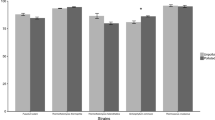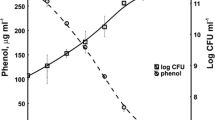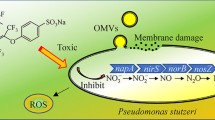Abstract
Only bacteria sufficiently resistant to the toxic compounds in their environment can be used for the efficient biodegradation process in order to eliminate a widespread contamination by polychlorinated biphenyls (PCBs). The presence of PCBs results in bacterial controlled rigidification of cytoplasmic membrane. The four bacterial isolates from long-term PCB-contaminated soil (Alcaligenes xylosoxidans, Pseudomonas stutzeri) and sediment (Ochrobactrum anthropi, Pseudomonas veronii) have been used to select the strain most adapted to the PCBs, i.e. with efficient changes in the membrane phospholipid fatty acids. PCBs and their toxic degradation products — the 3-chlorobenzoic acids (3-CBA as the most toxic one) — were added separately to the liquid medium with glucose in two experimental sets: at lag phase and in stationary phase of bacterial growth in order to evaluate the effects of chemicals to cytoplasmic membrane. The main parameter — the changes in fatty acids composition (in the total lipids and the main membrane phospholipid phosphatidyletanolamine) were studied. 3-CBA caused growth inhibition when added at lag phase. However, when added during the stationary growth, inhibition was not observed. Similarly, after addition of PCBs to the stationary growth culture, inhibition of growth was not observed with all tested strains (except for P. stutzeri). This fact indicates the importance of time contact of bacteria during growth phase with xenobiotics. O. anthropi and A. xylosoxidans appeared to be the most adapted to the presence of PCBs (with sufficient membrane adaptation), active under the adverse conditions, and able to survive in the contaminated environment.
Similar content being viewed by others
Abbreviations
- 3-CBA:
-
3-chlorobenzoic acid
- MM medium:
-
minimal mineral medium
- PCBs:
-
polychlorinated biphenyls
References
Christopherson S.W. & Glass R.L. 1969. Preparation of milk fat methyl esters by alcoholysis in an essentially nonalcoholic solution. J. Dairy Sci. 52: 1289–1290.
Čertík M., Dercová K., Sejáková Z., Finďová M. & Jakubík T. 2003. Efect of polyaromatic hydrocarbons (PAHs) on the membrane lipids of bacterial cell. Biologia 58: 1111–1117.
Čertík M. & Shimizu S. 2000. Kinetic analysis of oil biosynthesis by arachidonic acid-producing fungus, Mortierella alpina 1S-4. Appl. Microbiol. Biotechnol. 54: 224–230.
Denich T.J., Beaudette L.A., Lee H. & Trevor S.J.T. 2003. Effect of selected environmental and physicochemical factors on bacterial cytoplasmic membranes. J. Microbiol. Methods 52: 149–182.
Dercová K., Vrana B., Baláž Š. & Šándorová A. 1996. Biodegradation and evaporation of polychlorinated biphenyls (PCBs) in liquid medium. J. Ind. Microbiol. 16: 325–329.
Dercová K., Šeligová J., Dudášová H., Mikulášovvá M., Šilharová K. & Hucko P. 2009. Characterization of the bottom sediments contaminated with polychlorinated biphenyls: evaluation of ecotoxicity and biodegradability. Int. Biodeter. Biodegr. 63: 440–449.
Dudášová H., Lukáčová L., Murínová S. & Dercová K. 2012. Effects of plant terpenes on biodegradation of polychlorinated biphenyls (PCBs). Int. Biodeter. Biodegr. 69: 23–27.
Hickey J. 1999. Transformation and fate of polychlorinated biphenyls in soil and sediment, pp. 315–338. In: Adriano D.C., Bollag J.M., Frankenberger W.T. & Sims R.C. (eds), Bioremediation of Contaminated Soil. Soil Science Society of America Inc., USA.
Heipieper H.J., Diefenbach R. & Keweloh H. 1992. Conversion of cis unsaturated fatty acids to trans, a possible mechanism for the protection of phenol-degrading Pseudomonas putida P8 from substrate toxicity. Appl. Environ. Microbiol. 58: 1847–1852.
Heipieper H.J., Meinhardt F. & Segura A. 2003. The cis-trans isomerase of unsaturated fatty acids in Pseudomonas and Vibrio: biochemistry, molecular biology and physiological function of a unique stress adaptive mechanism. FEMS Microbiol. Lett. 229: 1–7.
Heipieper H.J., Weber F.J., Sikkema J., Keweloh H. & de Bont J.A.M. 1994. Mechanisms of resistance of whole cells to toxic organic solvents. Trends Biotechnol. 12: 409–415.
Kočan A., Petrík J., Jursa S., Chovancová J. & Drobná B. 2001. Environmental contamination with polychlorinated biphenyls in the area of their former manufacture in Slovakia. Chemosphere 43: 596–600.
Martínez P., Agulló L. & Hernández M. 2007. Chlorobenzoate inhibits growth and induces stress proteins in the PCBdegrading bacterium Burkholderia xenovorans LB400. Arch. Microbiol. 188: 289–297.
Megharaj M., Ramakrishnan B., Venkateswarlu K., Sethunathan N. & Naidu R. 2011. Bioremediation approaches for organic pollutants: a critical perspective. Environ. Int. 37: 1362–1375.
Mrozik A., Cycoń M. & Piotrowska-Seget Z. 2010. Changes of FAME profiles as a marker of phenol degradation in different soils inoculated with Pseudomonas sp. CF6600. Int. Biodeter. Biodegr. 64: 86–96.
Mrozik A. & Piotrowska-Seget Z. 2010. Bioaugmentation as a strategy for cleaning up of soils contaminated with aromatic compounds. Microbiol. Res. 165: 363–375.
Parnell J.J., Denef V.J., Park J., Tsoi T. & Tiedje J.M. 2010. Environmentally relevant parameters affecting PCB degradation: carbon source- and growth phase-mitigated effects of the expression of the biphenyl pathway and associated genes in Burkholderia xenovorans LB400. Biodegradation 21: 147–156.
Pepi M., Heipieper H.J., Fischer J., Ruta M., Volterrani M. & Focardi S.E. 2008. Membrane fatty acids adaptive profile in the simultaneous presence of arsenic and toluene in Bacillus sp. ORAs2 and Pseudomonas sp. ORAs5 strains. Extremophiles 12: 343–349.
Segura A., Duque E., Msqueda G., Ramos J.L. & Junker F. 1999. Multiple responses of Gram-negative bacteria to organic solvents. Environ. Microbiol. 1: 191–198.
Sikkema J., de Bont J.A.M. & Poolman B. 1995. Mechanisms of membrane toxicity of hydrocarbons. FEMS Microbiol. Rev. 59: 201–222.
Unell M., Kabelitz N., Jansson J.K. & Heipieper H.J. 2007. Adaptation of the psychrotroph Arthrobacter chlorophenolicus A6 to growth temperature and the presence of phenols by changes in the anteiso/iso ratio of branched fatty acids. FEMS Microbiol. Lett. 266: 138–142.
Unterman R., DeFlaun M. & Steffan R. 2000. Advanced in situ bioremediation — a hierarchy of technology choices, pp. 134–145. In: Rehm H.J. & Reed G. (eds) Biotechnology, Environmental Processes II: Soil Decontamination. Wiley-Verlag, Weinheim, Germany.
Weber F.J. & de Bont J.A.M. 1996. Adaptation mechanisms of microorganisms to the toxic effects of organic solvents on membranes. Biochim. Biophys. Acta 1286: 225–245.
Zorádová-Murínová S., Dudášová H., Lukáčová L., Čertík M., Šilharová K., Vrana B. & Dercová K. 2012. Adaptation mechanisms of bacteria during the degradation of polychlorinated biphenyls in the presence of natural and synthetic terpenes as potential degradation inducers. Appl. Microbiol. Biotechnol. 94: 1375–1385.
Zorádová S., Dudášová H., Lukáčová L., Dercová K. & Čertík M. 2011. The effect of polychlorinated biphenyls (PCBs) on the membrane lipids of Pseudomonas stutzeri. Int. Biodeter. Biodegr. 65: 1019–1023.
Author information
Authors and Affiliations
Corresponding author
Rights and permissions
About this article
Cite this article
Murínová, S., Dercová, K., Čertík, M. et al. The adaptation responses of bacterial cytoplasmic membrane fluidity in the presence of environmental stress factors — polychlorinated biphenyls and 3-chlorobenzoic acid. Biologia 69, 428–434 (2014). https://doi.org/10.2478/s11756-014-0337-0
Received:
Accepted:
Published:
Issue Date:
DOI: https://doi.org/10.2478/s11756-014-0337-0




